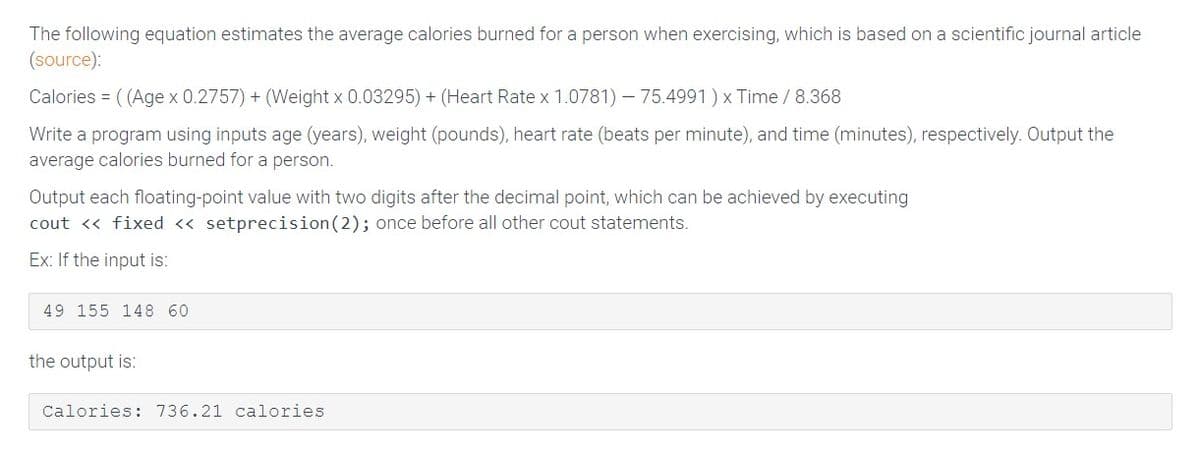The following equation estimates the average calories burned for a person when exercising, which is based on a scientific journal article (source): Calories = ((Age x 0.2757) + (Weight x 0.03295) + (Heart Rate x 1.0781) - 75.4991) x Time / 8.368 Write a program using inputs age (years), weight (pounds), heart rate (beats per minute), and time (minutes), respectively. Output the average calories burned for a person. Output each floating-point value with two digits after the decimal point, which can be achieved by executing cout << fixed << setprecision (2); once before all other cout statements. Ex: If the input is: 49 155 148 60 the output is: Calories: 736.21 calories.
The following equation estimates the average calories burned for a person when exercising, which is based on a scientific journal article (source): Calories = ((Age x 0.2757) + (Weight x 0.03295) + (Heart Rate x 1.0781) - 75.4991) x Time / 8.368 Write a program using inputs age (years), weight (pounds), heart rate (beats per minute), and time (minutes), respectively. Output the average calories burned for a person. Output each floating-point value with two digits after the decimal point, which can be achieved by executing cout << fixed << setprecision (2); once before all other cout statements. Ex: If the input is: 49 155 148 60 the output is: Calories: 736.21 calories.
Computer Networking: A Top-Down Approach (7th Edition)
7th Edition
ISBN:9780133594140
Author:James Kurose, Keith Ross
Publisher:James Kurose, Keith Ross
Chapter1: Computer Networks And The Internet
Section: Chapter Questions
Problem R1RQ: What is the difference between a host and an end system? List several different types of end...
Related questions
Question

Transcribed Image Text:The following equation estimates the average calories burned for a person when exercising, which is based on a scientific journal article
(source):
Calories = ( (Age x 0.2757) + (Weight x 0.03295) + (Heart Rate x 1.0781) – 75.4991) x Time /8.368
Write a program using inputs age (years), weight (pounds), heart rate (beats per minute), and time (minutes), respectively. Output the
average calories burned for a person.
Output each floating-point value with two digits after the decimal point, which can be achieved by executing
cout <« fixed <« setprecision(2); once before all other cout statements.
Ex: If the input is:
49 155 148 60
the output is:
Calories: 736.21 calories
Expert Solution
This question has been solved!
Explore an expertly crafted, step-by-step solution for a thorough understanding of key concepts.
This is a popular solution!
Trending now
This is a popular solution!
Step by step
Solved in 3 steps with 1 images

Recommended textbooks for you

Computer Networking: A Top-Down Approach (7th Edi…
Computer Engineering
ISBN:
9780133594140
Author:
James Kurose, Keith Ross
Publisher:
PEARSON

Computer Organization and Design MIPS Edition, Fi…
Computer Engineering
ISBN:
9780124077263
Author:
David A. Patterson, John L. Hennessy
Publisher:
Elsevier Science

Network+ Guide to Networks (MindTap Course List)
Computer Engineering
ISBN:
9781337569330
Author:
Jill West, Tamara Dean, Jean Andrews
Publisher:
Cengage Learning

Computer Networking: A Top-Down Approach (7th Edi…
Computer Engineering
ISBN:
9780133594140
Author:
James Kurose, Keith Ross
Publisher:
PEARSON

Computer Organization and Design MIPS Edition, Fi…
Computer Engineering
ISBN:
9780124077263
Author:
David A. Patterson, John L. Hennessy
Publisher:
Elsevier Science

Network+ Guide to Networks (MindTap Course List)
Computer Engineering
ISBN:
9781337569330
Author:
Jill West, Tamara Dean, Jean Andrews
Publisher:
Cengage Learning

Concepts of Database Management
Computer Engineering
ISBN:
9781337093422
Author:
Joy L. Starks, Philip J. Pratt, Mary Z. Last
Publisher:
Cengage Learning

Prelude to Programming
Computer Engineering
ISBN:
9780133750423
Author:
VENIT, Stewart
Publisher:
Pearson Education

Sc Business Data Communications and Networking, T…
Computer Engineering
ISBN:
9781119368830
Author:
FITZGERALD
Publisher:
WILEY